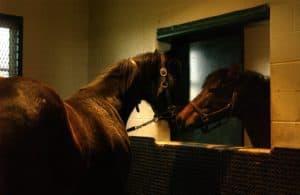
Managing a Shy Breeding Stallion
My stallion shows little or no signs of libido with my mare. He won’t even talk to her. What can I do?

My stallion shows little or no signs of libido with my mare. He won’t even talk to her. What can I do?

Owners can take several steps to ensure a successful transition from athletic to breeding performance.

Dr. Nancy Diehl offers advice on keeping stallions happy and safe during routine handling and breeding.

The time required to train a stallion to use a dummy mount can range from few days to several weeks.
I desperately need some advice about my new colt. He is a 2?-year-old Gypsy Cob named Geordie. He was raised in a herd, then separated as a yearling colt, and ran with a colt herd until I imported him to Australia. He is naturally gentle and not
The Havemeyer Equine Behavior Lab and the Section of Reproduction at the University of Pennsylvania’s New Bolton Center is offering a stallion handling course for veterinarians, stallion owners, and managers. The two-day course will focus on
Q: I have worked with many different breeding stallions, including Thoroughbreds and Warmbloods back east, then mostly Arabians and Quarter Horses in Texas. We now have a halter stallion that does something I’ve never seen
A stallion handler must be able to focus the stallion’s mind on him, as well as the mare, and make him wait for instructions. This cannot be achieved through fear or abusiveness, but through training basic cues and maneuvers to the stallion before he
We purchased a stallion for breeding at nine years of age. He had bred before, but curiously had very few offspring for his impeccable credentials. He was a lovely stallion, very well-behaved, and a perfect gentleman to work around. When we
Our stallion has a great pedigree, and we have kept him intact hoping he could eventually become a breeding stallion. We?ve put a lot of effort into getting him to show well enough to be worth breeding. He has always done really well except for
Presentations on reproduction have long been a hallmark of AAEP gatherings, and this year was no exception. The full-day reproduction session was split into two parts–the first was of a general nature, while the afternoon in-depth session
Envision this: In his first season, the young stallion fulfills his purpose as a breeding animal. He matures from a rambunctious colt into a skillful stud. So how do you make this dream a reality? As the handler, you want the horse to behave
When a mare and a stallion meet, love might be in the air…but there’s the potential for danger, too. Particularly when humans get in the middle of it all. In our efforts to orchestrate the best possible combinations of
Artificial Insemination (AI) involves the introduction of sperm into the reproductive tract of the mare without natural mating. AI in the horse was first practiced long ago. Ancient Arabian texts describe how mares were successfully inseminated.
Given the choice, a stallion wouldn’t choose to mate with man-made devices. His instincts drive him to breed a mare; yet he can learn to transfer his sexual focus to a phantom mare and an artificial vagina (AV). In order to train a stallion fo”P>Given the choice, a stallion wouldn’t choose to mate with man-made devices
Artificial insemination of equines has been around a long time and, through the years, has had a profound impact on the horse industry. Most of the impact has been of the positive variety, but there also have been some negatives. Just when
Stay on top of the most recent Horse Health news with
© 2022 Copyright Statement dolor sit amet, consetetur sadipscing User Terms, sed diam nonumy eirmod tempor invidunt ut labore et dolore magna aliquyam erat, sed diam voluptua. At vero eos et accusam et justo duo dolores et ea rebum. Stet clita kasd gubergren, no sea takimata sanctus est Lorem ipsum dolor sit amet.
"*" indicates required fields